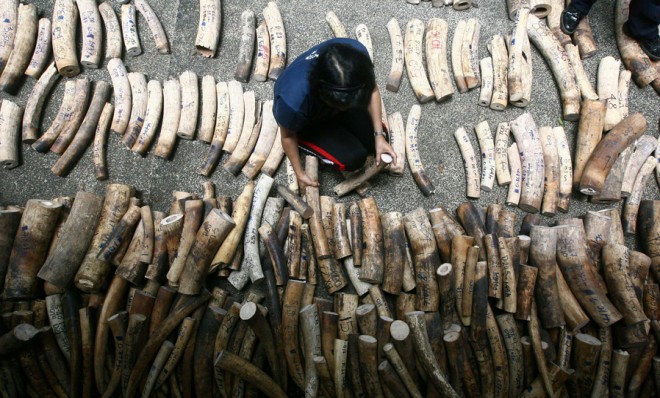Why the Philippines is destroying $6.5 million worth of illegal ivory
The island nation's government wants to send a message that the massacre of elephants will not be tolerated

As a symbolic gesture denouncing worldwide ivory trafficking, the Philippines plans on destroying five tons of seized ivory on Friday. With the slaughter of elephants approaching its worst level in a decade, the predominantly Roman Catholic nation will be the first ivory-consuming country to destroy its stock of harvested "blood ivories."
"This action is meant to send a message that the Philippines is against the illegal trade of ivory and the merciless massacre of elephants," Protected Areas and Wildlife Bureau head Theresa Mundita Lim told AFP.
On Friday morning, five tons (worth $6.5 million) of the nation's 13.1 tons of Tanzanian elephant tusks seized from 2005 to 2009 will be laid out before a fleet of industrial rollers and ceremonially crushed. Originally, the plan was to burn the remnants, but the gesture was scrapped due to pressure from environmental groups, who argued that a fire would produce too much smoke.
The Week
Escape your echo chamber. Get the facts behind the news, plus analysis from multiple perspectives.

Sign up for The Week's Free Newsletters
From our morning news briefing to a weekly Good News Newsletter, get the best of The Week delivered directly to your inbox.
From our morning news briefing to a weekly Good News Newsletter, get the best of The Week delivered directly to your inbox.
The nation's remaining ivory cache will then be locked away to be used as evidence against law-breaking ivory traders, and to educate the island's population about the violent extremes employed by the global penumbra of elephant poachers, which were highlighted in a 2012 National Geographic magazine cover story by Bryan Christy. Here's the brutal opening passage:
In January 2012 a hundred raiders on horseback charged out of Chad into Cameroon's Bouba Ndjidah National Park, slaughtering hundreds of elephants — entire families — in one of the worst concentrated killings since a global ivory trade ban was adopted in 1989. Carrying AK-47s and rocket-propelled grenades, they dispatched the elephants with a military precision reminiscent of a 2006 butchering outside Chad's Zakouma National Park. […] From the air too the scattered bodies present a senseless crime scene — you can see which animals fled, which mothers tried to protect their young, how one terrified herd of 50 went down together, the latest of the tens of thousands of elephants killed across Africa each year. Seen from higher still, from the vantage of history, this killing field is not new at all. It is timeless, and it is now. [National Geographic]
Imported ivory has been banned for more than two decades in the Philippines. Still, illegal ivory imported from Africa by way of China is used to pay homage to the country's venerated religious icons, namely the Santo Niño de Cebu — a small, ornate statue of the child Jesus dressed as a king. It is believed that the Spanish, led by Ferdinand Magellan, used the image of the Santo Niño to convert the small island nation to Catholicism in the early 16th century. Though the statue is often made from wood or fiberglass, many Catholic Filipinos prefer their religious iconography carved in more exquisite materials, especially ivory.
The local Catholic church has even been implicated in ivory smuggling, although church authorities deny involvement, asserting that their ivory statues have been in the church's possession long before a 1989 ban was imposed.
The global ivory trade doesn't just slaughter elephants, either: Human lives are at risk, too. According to the World Wildlife Federation, 10 guards were killed by Sudanese poachers in Chad's Zakouma National Park between 2006 and 2009. On the Asian black market, ivory can fetch upwards of $2,000 per kilogram.
A free daily email with the biggest news stories of the day – and the best features from TheWeek.com
-
 5 loony toons about the Warner Bros. buyout
5 loony toons about the Warner Bros. buyoutCartoons Artists take on movie theaters, high quality cinema, and more
-
 Political cartoons for December 13
Political cartoons for December 13Cartoons Saturday's political cartoons include saving healthcare, the affordability crisis, and more
-
 Farage’s £9m windfall: will it smooth his path to power?
Farage’s £9m windfall: will it smooth his path to power?In Depth The record donation has come amidst rumours of collaboration with the Conservatives and allegations of racism in Farage's school days